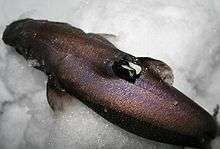Anelasma
| Anelasma | |
|---|---|
 | |
| Velvet belly lanternshark with Anelasma | |
| Scientific classification | |
| Kingdom: | Animalia |
| Phylum: | Arthropoda |
| Subphylum: | Crustacea |
| Class: | Maxillopoda |
| Infraclass: | Cirripedia |
| Order: | Pedunculata |
| Family: | Anelasmatidae Gruvel, 1905 |
| Genus: | Anelasma Darwin, 1851 |
| Species: | A. squalicola |
| Binomial name | |
| Anelasma squalicola (Lovén, 1844)[1] | |
Anelasma is a monotypic genus of parasitic goose barnacles. It contains a single species, Anelasma squalicola.[1][2] The nominal species, however, has a very broad distribution and may in fact contain several undescribed species.[3]
Anelasma are mesoparasitic barnacles that can be found attached to several species of deep-sea squaloid sharks, including at least black dogfish (Centroscyllium fabricii), combtooth dogfish (Centroscyllium nigrum), velvet belly lanternshark (Etmopterus spinax), fringefin lanternshark (E. schultzi), great lanternshark (E. princeps), brown lanternshark (E. unicolor), and southern lanternshark (E. granulosus). Anelasma are partially embedded in the flesh of the host, and seem to retard sexual development of their hosts, apparently castrating them.[3]
References
- 1 2 "Anelasma squalicola (Lovén, 1844)". Integrated Taxonomic Information System. Retrieved March 8, 2013.
- ↑ WoRMS. "Anelasma squalicola Darwin, 1851". World Register of Marine Species. Retrieved March 8, 2013.
- 1 2 Yano, K.; Musick, J. A. (2000). "The effect of the mesoparasitic barnacle Anelasma on the development of reproductive organs of deep-sea squaloid sharks, Centroscyllium and Etmopterus". Environmental Biology of Fishes. 59 (3): 329–339. doi:10.1023/A:1007649227422.
External links
- Tommy Leung (2010). "May 4 - Anelasma squalicola". Parasite of the Day. Retrieved 8 March 2013.